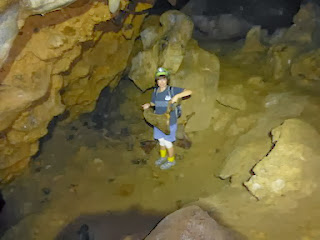It was documented by British geologists in the 1940s and shown on geological maps since then. It was initially written as Chadu, but now the 'h' has been dropped. Richardson wrote "Many of the limestone hills, notably Gua Chadu, ....., contain extensive caves, most of them festooned with stalactites and stalagmites.".
The limestone here is quite young compared to other parts of the peninsula.
As the hill has never been explored by cavers, we went to have a look 18 Nov 2013.
We went in from the north, from Pulai near Gua Musang. Much to my surprise there is a track all the way, although of course a 4WD is definitely needed. We passed some other limestone hills -
 |
| Gua Sembuang |
and had to do a river crossing, luckily this car came through first so we were able to see how deep the water was
Part of the area is taken over by the Pulai mining company.
Gua Cadu is quite small and not very high but contains a large cave. Large in terms of passage size but it is not long.
The entrance is large. The slope up into the entrance chamber is well used by elephants. We have now seen a few caves in the Merapoh area which are visited by elephants, see separate blog.
A passage leads down into a small chamber and I found elephant bones here. Seemed to be a young elephant. The poor thing probably went down into that area and couldn't get out and must have suffered a horrible slow death by starvation. There was no sign of the skull.
A climb leads up into the main passage which goes through the hill to another entrance.
There are some nice gour pools and above those, another climb leads to a large dry passage also going to another entrance. This is used by serows (mountain goats) as a toilet. It was good to see that
they only dirty 2 places and don't use the whole cave as their toilet.
 |
| fresh and old serow droppings |
 |
| Looking out to the main entrance from the upper chamber |
After lunch we continued driving along the logging trails. There is much evidence of logging, see separate blog.
I knew there are some long limestone hills to the south west, about 4 km long according to the map. We were eventually able to see them, although the view was obstructed by bamboo and there was a blue haze. These should be Gua Jadur and Timah.
.
As already mentioned there were quite a lot of signs of logging
We eventually came out at Sg Temau. It had taken almost 2 hours to get to the cave and another 2 hours to get out back to the main road.
-----------
See more on the elephants
and the logging and deforestation
-------------
© Liz Price
No reproduction without permission

















































